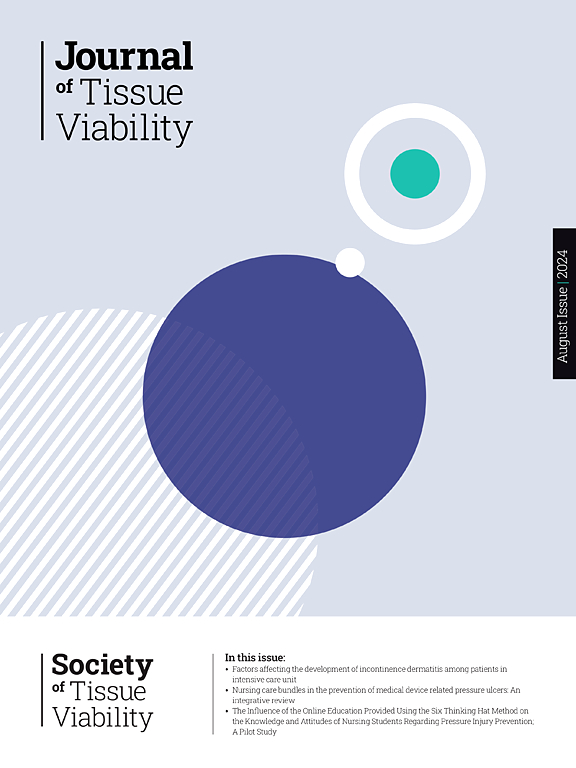Evaluation of storage parameters of platelet-rich plasma in functional assay of epithelial gap repair
IF 2.4
3区 医学
Q2 DERMATOLOGY
引用次数: 0
Abstract
Platelet-rich plasma (PRP), produced from autologous blood and containing growth factors, has shown promise in treating various conditions, including diabetic wounds. However, as expected, patient compliance is low in the context of repeated treatments as required for hard-to-heal wounds. This study investigates the efficacy of PRP stored under refrigeration for up to 2 weeks in promoting in-vitro human epithelial cell gap closure. PRP was prepared from six healthy individuals and immediately split into sterile test tubes for storage at 4 °C; the impact of fresh PRP on epithelial gap closure was compared to paired PRP samples stored for one and two weeks. According to gap closure analysis, 5 out of 6 individuals depicted accelerated epithelial gap closure compared to control conditions. There was no significant difference between fresh and refrigerated samples. An overall benefit was observed for using 1-week old samples over 2-week-old samples. Interestingly, according to a 6-hr epithelial gap analysis, significantly accelerated cell migration was obtained by 1-week-old refrigerated samples compared to their corresponding fresh PRP samples. The current study provides data in support of increasing the accessibility of PRP treatment for patients with hard-to-heal wounds. Patients can potentially self-treat between wound clinic appointments by using refrigerated sterile aliquots of their fresh PRP. Notably, by the end of two weeks, refrigerated PRP will not act as fresh PRP. More research is needed to fully investigate the effect of refrigeration on PRP sample efficacy, including larger cohorts, clinical wounds, and an evaluation of the molecular fingerprint of refrigerated PRP samples.

富血小板血浆储存参数在上皮间隙修复功能测定中的评价。
富血小板血浆(PRP)由自体血液产生,含有生长因子,在治疗各种疾病,包括糖尿病伤口方面显示出前景。然而,正如预期的那样,在难以愈合的伤口需要反复治疗的情况下,患者的依从性很低。本研究探讨了冷冻保存2周的PRP促进体外人上皮细胞间隙闭合的功效。从6个健康个体中制备PRP,并立即分成无菌试管,在4°C保存;将新鲜PRP对上皮间隙闭合的影响与储存一周和两周的配对PRP样品进行比较。根据间隙闭合分析,与对照组相比,6个个体中有5个描述了加速的上皮间隙闭合。新鲜和冷藏样品之间没有显著差异。总的来说,使用1周的样本比使用2周的样本有好处。有趣的是,根据一项6小时的上皮间隙分析,与相应的新鲜PRP样品相比,1周龄的冷藏样品显著加速了细胞迁移。目前的研究提供的数据支持增加难以愈合的伤口患者的PRP治疗的可及性。患者可以通过使用新鲜PRP的冷藏无菌等量,在伤口门诊预约之间进行潜在的自我治疗。值得注意的是,在两周结束时,冷藏的PRP将不如新鲜的PRP。需要更多的研究来充分研究冷藏对PRP样品疗效的影响,包括更大的队列、临床伤口和冷藏PRP样品的分子指纹评估。
本文章由计算机程序翻译,如有差异,请以英文原文为准。
求助全文
约1分钟内获得全文
求助全文
来源期刊

Journal of tissue viability
DERMATOLOGY-NURSING
CiteScore
3.80
自引率
16.00%
发文量
110
审稿时长
>12 weeks
期刊介绍:
The Journal of Tissue Viability is the official publication of the Tissue Viability Society and is a quarterly journal concerned with all aspects of the occurrence and treatment of wounds, ulcers and pressure sores including patient care, pain, nutrition, wound healing, research, prevention, mobility, social problems and management.
The Journal particularly encourages papers covering skin and skin wounds but will consider articles that discuss injury in any tissue. Articles that stress the multi-professional nature of tissue viability are especially welcome. We seek to encourage new authors as well as well-established contributors to the field - one aim of the journal is to enable all participants in tissue viability to share information with colleagues.
 求助内容:
求助内容: 应助结果提醒方式:
应助结果提醒方式:


